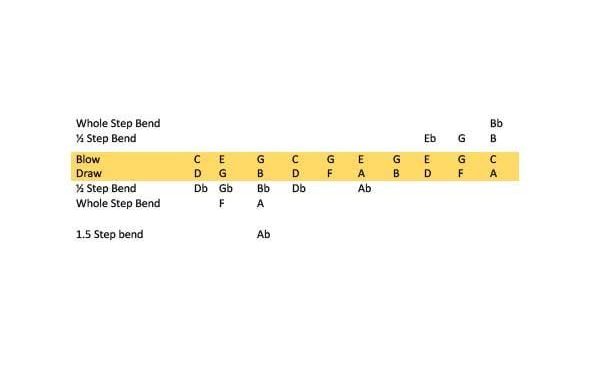This article is from an external source, and may contain external links not controlled by Empeda Music.The Harmonica Company
Second Position on the Harmonica Explained
If you’re new to the harmonica there’s a good chance you’ve started by purchasing a harp in the key of C, and have tried to play along with something bluesy in that key. The results have probably been a little disappointing; you’re trying to sound like Little Walter, but the sound coming out of your harmonica is more akin to that made by little Johnny and his recorder from next door . Don’t worry, though – this is perfectly normal, and, in this article I’ll show you how using what is known as second position on the harp can make a big difference to your sound.
Prerequisites
First, though, it’s important to be able to do two things in order to make the most of altered positions: play single notes cleanly, and bend notes. Both skills are linked, as it’s very difficult to bend notes properly if you’re sounding more than one note at the same time. We won’t go into detail about how to do this here, but there are plenty of great videos available online, such as this one from Ben Hewlett: https://www.youtube.com/watch?v=–CNIxlJ9OA
Positions
So, what do I mean by second position (or third or fourth position for that matter)? Let’s look at how a harp is tuned first to help us understand what these terms mean.
Traditional 10 hole harps are diatonic. This means that they are tuned as standard to play only the notes of the designated key (leaving aside bent notes, for now). The easiest way to visualise this is to picture a piano keyboard; on a C harp, for instance, only the white notes are available if the harmonica is played without any bending being used. In comparison, a chomatic harmonica has access, as standard, to all of the white notes and all of the black notes.
Now, it is possible to access those black notes on a diatonic harmonica in C by bending one of the white notes down (ie lowering the pitch). It’s worth noting, though, that the standard draw bending technique will only work on holes 1 – 6; bends higher up require the slightly more tricky blow bends. Let’s have a look at what bends we have available when playing as standard (which is known as first position).

For the major blues scale in C, the only note we need from outside of the C major scale is Eb. For the minor blues scale, though, we also need Bb and Gb (or F# as we may also call it). Now, it’s possible to access all of the notes you need for both blues scales in first position with 1/2 step bends. The problem, though, is that these notes aren’t really in the places you need them to be for fluent playing; Gb and Bb are draw bends on holes two and three, but Eb is all the way up on hole eight as a blow bend. Not ideal.
For the major blues scale in C, the only note we need from outside of the C major scale is Eb. For the minor blues scale, though, we also need Bb and Gb (or F# as we may also call it). Now, it’s possible to access all of the notes you need for both blues scales in first position with 1/2 step bends. The problem, though, is that these notes aren’t really in the places you need them to be for fluent playing; Gb and Bb are draw bends on holes two and three, but Eb is all the way up on hole eight as a blow bend. Not ideal.
The solution is second position. This is where you play the same harmonica in a key that is seven semitones (a perfect fifth) up from its designated key. So a C harmonica would be played in G (G is exactly seven notes, both black and white above C on a piano keyboard).
Because the keys of C and G are closely related harmonically, they share most of the same notes. The only differences are the use of an F# in G rather than an F, and the fact that G is the tonic (the focal point of the key) rather than C.
For the major and minor blues scales in G, we need one or all, respectively, of the following notes from outside the G major scale: Bb, Db and F. Take a look at the chart above and you’ll see that these notes are now easily accessible on a C harp between holes 1 and 5, making it much easier to play blues licks fluidly.
The easiest way to truly understand 2nd position is just to play with it! Find a piece of music that you know is in G (Google is your friend for identifying the key signatures of songs quickly) and which doesn’t stray too far from its tonic, and just play along with a few draw bends on holes two and three. You’ll soon find that your playing sounds quite different to when you were using straight harp (first position).
There are, of course, further positions – third, fourth, fifth and beyond are generally less frequently used, but open up new avenues of harmonic possibility. Third position, for instance, which is a further seven semitones up from second position, would give the key of D on a C harp, and is more minor in feel than first or second position.
Ultimately, the key is practice and experimentation. Keep these up and you’ll soon be getting some more interesting sounds from your harp.
JP
The post Harmonica Positions Explained appeared first on The Harmonica Company.
